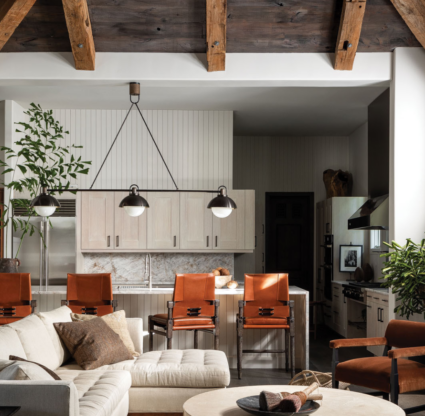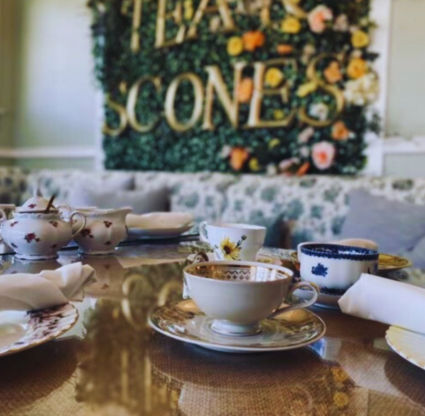Perched atop rolling hills, in the charming village of Rigomagno, stands Podere San Michele, Karen and John Abell’s 17th-century Tuscan farmhouse. The property overlooks olive groves, the sangiovese and vermentino grapevines the couple planted in 2021, and the rolling hills of the Val di Chiana valley. Karen walks her property to gather herbs and produce, and her life unfolds like a sun-kissed dream with roaming deer, wild boar and singing cicadas. “The pace of life here is just so relaxed,” Karen says. “Everything feels slow. People take their time, and they ask how you are.”
The scene is a world away from the couple’s other hometown in Southwest Florida, where they own Patina Collection, the Naples Third Street South boutique, known for its considered blend of antiques, patterned private-label upholstery and carefully curated artisan goods from around the world. A former realtor, Karen opened Patina 11 years ago as a consignment stall at Naples’ Chesterdales Home & Garden. Over the years, the shop evolved to reflect Karen’s heritage-inspired aesthetic. Tuscany’s unhurried attitude spills into every facet of her life, including two of the homes she owns, 5,000 miles away from each other. (The Abells also have a brownstone in Chicago, where Karen is opening a second location for Patina.)
Despite their keen differences—the Naples home is brighter and lighter with white walls, big windows and a beachy undercurrent; Tuscany is darker, rustic and delightfully imperfect—Karen’s style shines through. Karen considers herself the antithesis of the clean-lined, stark contemporary movement. “I like to be enveloped in a space,” she says. She likes to look around and see pieces of her family’s history, works from maker friends, her prized collections and relics from past travels. “I don’t like sparseness—I like to feel warm and like it’s OK to jump on the sofa,” she says.
In both homes, plush seating pushes up against well-worn antiques, and surfaces are generously adorned. In Naples, the frills lean toward coral, shell boxes, crystal vases and bowls, and pretty trays. In Italy, it’s more candlesticks, tarnished silver and brass, and blue-and-white ceramics from the Italian town of Gubbio. Woven baskets are set on walls and floors in both places, ready to gather garden pickings.
Her homes reflect Karen’s propensity for collecting. Peppered throughout walls, you’ll see clusters of the transferware she’s collected since her grandparents gifted her first pieces. Crystal and silver also feature prominently, and she’s an avid collector of shell boxes, which remind her of childhood days visiting Naples with her family in the ’70s. “I’ve actually found a lot of [the shell boxes] in Italy,” she says.
Serendipity has a lot to do with what fills the shop and homes—Karen’s often stumbling across artisan makers and market finds on her travels around Italy and France. But, she’s also worked hard at developing a network of international sources to supply her authentic wares, like Parisian Carron ceramics and La Soufflerie handblown glass, Penny Morrison lamps from England, and Malaika Linens out of Cairo. For Karen, these items hold not just aesthetic value but also stories and connections with the people who created them. “I’ve visited most of their shops and [factories],” she says.
Elements of each hometown outfit the other home. She relies on her American sources for household staples that are hard to get in the remote Italian town (paper towels, Advil), as well as her favored assortment of chintz, damask and ticking Schumacher, Cowtan & Tout and Lisa Fine Textiles. “Surprisingly, the old, patterned fabrics aren’t easy to find in Italy because everyone there wants contemporary,” Karen says. In Naples, French wrought-iron tables, bleached wood furnishings and traditional fabrics lend a lived-in character to the coastal home. (She’s partial to the two-door commode near the entryway and the living room’s traditional Tuscan console topped with a vintage Italian cherub candelabra.)
A few years ago, when Karen and John were looking to relocate closer to Downtown Naples, Karen longed for an older home with the character of her Chicago brownstone and Italian villa. She knew she wouldn’t find the depth of heritage from Europe but was appeased by the original brick floors and wood in the 1999-built Port Royal home the couple bought in 2020 and charmingly dubbed the Shell House. She played up the time-worn charm by staining the floors black (the same color as her Chicago floors), layering in sumptuous decor (like the Mark D. Sikes for Chaddock chocolate brown sofas, covered in velvet from Milan, in the living room), and importing character-rich decor. “We love very dark art, with an eye that draws you in,” she says. “We have a collection of eight, gilt-frame paintings stacked on walls—they don’t mean anything together, but I like how they look.” The pieces are similar to the moody Renaissance paintings that hang in her Tuscan home.
Karen’s Italian abode is her sanctuary, “an old shoe” that fits her as if it were made to measure. “Everything feels more ‘me,’” Karen says. “My house here in Naples is more public,” she says, recalling how more than 1,200 people came through the home during the 2023 Naples Garden Club’s House & Garden Tour. “I’ve always wondered if the design is perfect. But in the house in Italy, I just do whatever I want.” The farmhouse flaunts a wealth of pattern-on-pattern. “There are no rules at all,” she says. “Back in the United States, we tend to be very precise, and everything’s a little more planned.” Reds, purples and lush greens reflect the Italian penchant for deep hues. Blankets draped over sofas lend an air of casual elegance. Antique finds and meticulous craftsmanship tell stories of tradition and artistry. Hexagon tiles, terracotta floors and aged wooden beams speak to an unwavering commitment to the home’s origins. “Italians keep their furniture for a very long time,” she says. “They don’t [replace] things like we do or sell their houses as frequently. They live in the same house for a lifetime.”
Though the Abells had been traveling to Italy for about 15 years, they had never been to Tuscany and spent only three days in the region before buying the farmhouse. Living in a foreign country was never in the couple’s plans, but everything changed when they saw San Michele. “By the time we walked around the back of the property, John and I looked at each other and decided, ‘We’re buying this house,’” she says. “The tight spaces reminded us of the movie A Good Year—it’s one of our favorites. In the movie, the protagonist captures the beauty of the property over time, which resonated with us.” The classic stone Tuscan farmhouse, or podere, is surrounded by cultivated farmland and cypress and rare stone pine trees. The main house’s original four rooms are intact, including the kitchen, which is part of the 1600s watchtower that once stood on the property. The entrance is framed by rosemary, creating a delightful aroma upon arrival.
Still, San Michele is much more designed for living outside than lingering within the stone walls. “When we’re here in the fall, we pretty much just walk through the house,” Karen says. She furnished every nook that could be turned into an alfresco hangout. Wicker chairs and breakfast tables line the porch; old stone troughs were converted into water features and surrounded by lavender in one of the two verandas; comfy loungers surround the pool; and croquet and bocce ball courts adorn two lawns. “We have a massive, centuries-old oak that sits right on one of the terraces … We placed a table there to enjoy aperitivo while looking at the vineyard,” she says.
Continue on through the property and you’ll find various rose gardens, an abundant orchard and a potting shed where Karen makes decorative arrangements. A butterfly garden, filled with monarchs, leads to the new guest house, which Karen spent two years building out to replicate an authentic Tuscan villa on a micro-scale. Just outside La Villetta (The Little Villa), under a canopy of trees, she placed two outdoor beds for lounging.
The Abells spend most of their time in their screened-in porticato (similar to a lanai), located just off the kitchen. The space is filled with floral-draped tables and chairs, lots of lamps for soft lighting, and a record player, and depending on the time of day, cool breezes come in from different directions.
While life in Italy takes place mostly outdoors, the Naples home is designed for the more traditional American approach to indoor living. The place is cozy, with clearly defined spaces, rattan and antique furnishings, and a library chock-full of books and found objects. Karen claims the dining room as one of her favorite spots—especially when the morning sun casts a gentle glow and she can gaze upon the pink palm tree mural created by her friend Shiree Nichole.
Over her more than 50 years of visiting and living in Naples, Karen has witnessed the town’s evolution. The beauty of the beach, just five houses away, lend Karen a retreat from her busy life as a shopkeep and hostess. And, by infusing elements of Italy into the decor, Tuscany is never too far away. With a Negroni in hand, she and her husband recreate aperitivo gatherings that transport them, if only for a moment, back to the enchanting Italian countryside.
Tuscan home
Karen favors the patina (hence the name of her Patina Collection Naples decor boutique) that develops over centuries of lives lived within. Though the guest house in Italy was built new, she painstakingly recreated it in the fashion of traditional Tuscan villas. (Photo by Gabriele Bianchini)




